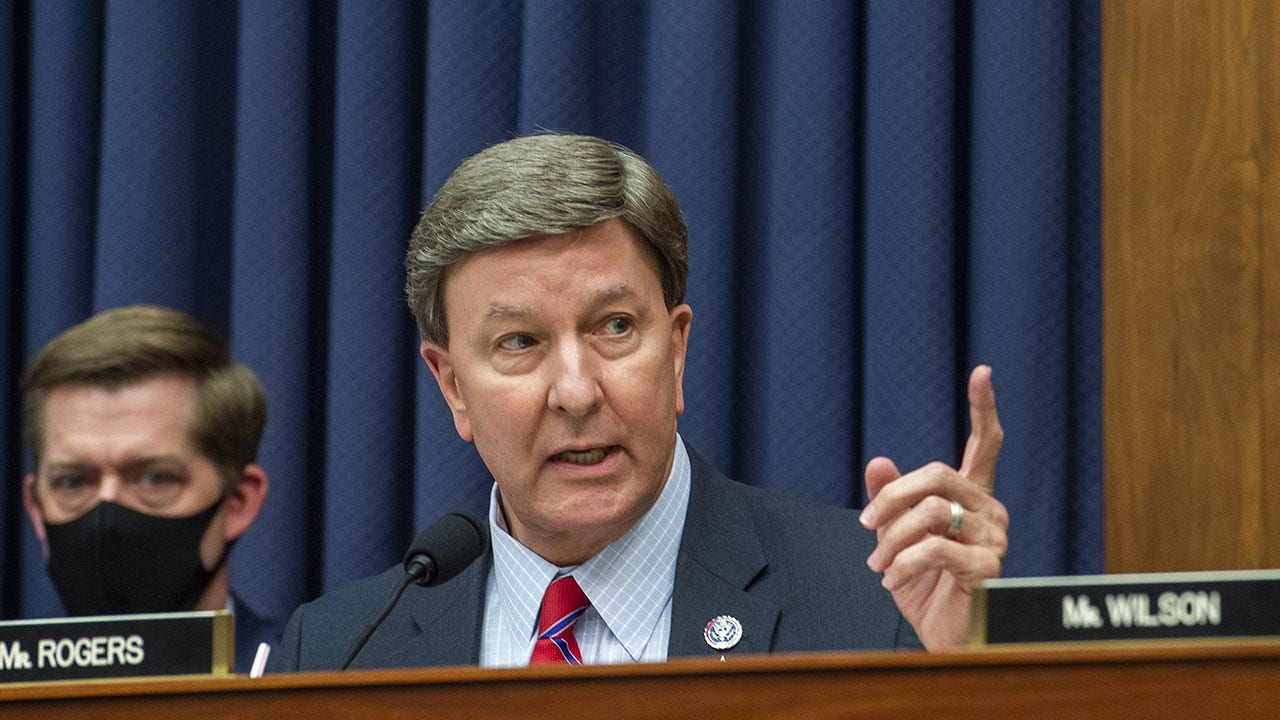Lifestyle
His 'funk is contagious.' This L.A. glassblower breaks the rules with his stunning vessels
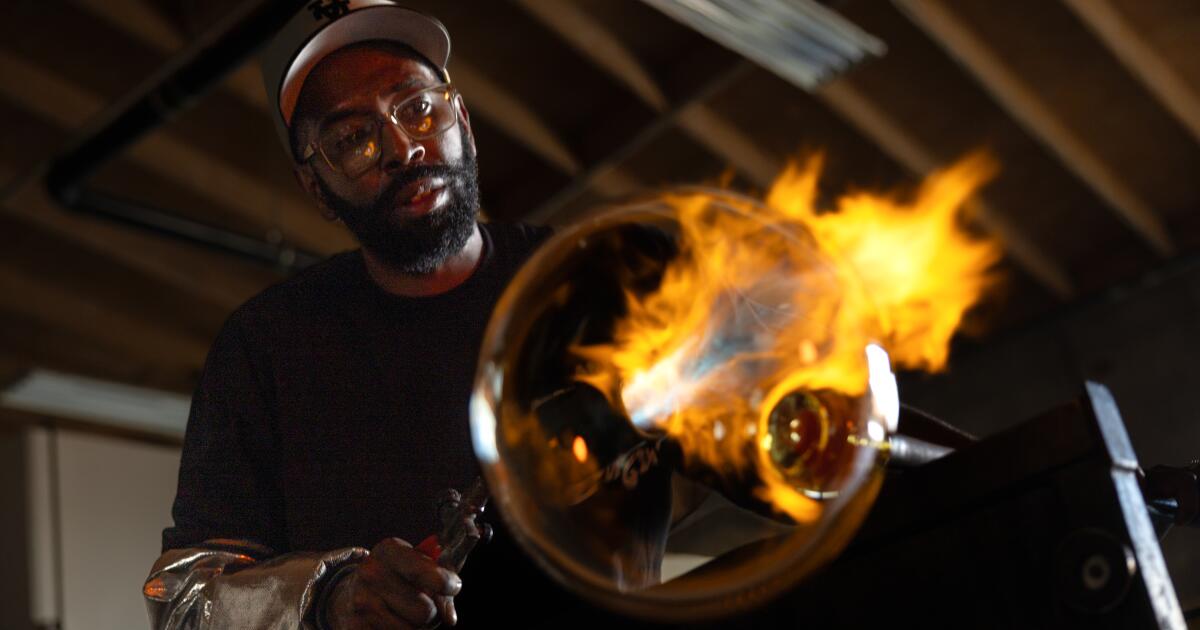
Seated on a chair, with the hum of twin furnaces and the Impressions playing in the background, glassblower Cedric Mitchell is lost in his craft as he and assistant Sara Roller turn and sculpt molten glass with steel shears.
After a few blasts of a blow torch and several trips back and forth to the furnace, the red-hot glass on the rod turns cobalt blue and forms what will eventually become a 7-inch vase.
Color is the first thing you notice about the artist’s hand-blown glass vessels.
“I love color,” Mitchell says, “which is weird because I wear black every day.”
Mitchell, 37, was an emerging hip-hop artist in Tulsa, Okla., when he first considered glassblowing. It was 2012, and he was recording a song in a Tulsa music studio when he noticed his friend’s impressive glass bong.
“He told me about a studio in downtown Tulsa where I could take a glass-blowing class as an elective at my community college,” says Mitchell, who was studying business at Tulsa Community College. “I immediately signed up for the class at 1 a.m.”
Colorful glass totems by glass artist Cedric Mitchell in his El Segundo studio.
(Robert Gauthier / Los Angeles Times)
Inspired by his friend’s bong, Mitchell had his heart set on making glass pipes.
But when he showed up for the first day of class at the Tulsa Glassblowing School, the instructor calmly explained that it was a nonprofit and that “we would not be making bongs,” Mitchell adds wryly.
Six months later, Mitchell was teaching glassblowing at the studio as an intern in exchange for practice time.
He stuck with it because it was difficult. “Glassblowing is one of the hardest things I’ve ever done,” Mitchell says. “It’s the most rewarding and also the most discouraging. Sometimes impostor syndrome sets in, and I wonder, ‘Am I even good at this?’ You must stay within the process instead of thinking of the outcome.”
When asked what inspires him, Mitchell’s list is endless: “I like graffiti, music, three-dimensional art, digital compositions that I see on Pinterest, furniture, Frank Lloyd Wright architecture, James Turrell sculptures. I also like a lot of fashion in bright colors. I used to be fashionable until I started blowing glass, and then I muted my color palette.”
Mitchell grew up in North Tulsa, a predominantly Black neighborhood where more than 35% of the population lives in poverty. When his mother remarried, his family moved to the South Side, where he attended what he describes as “a rich white school.” It was an experience that taught him how to “maneuver in both worlds.”
“I don’t know how I would have turned out if I had stayed in North Tulsa,” he says quietly. He remembers falling in love with music during his senior year of high school when he first heard Kanye West. “My English teacher told me I would be a great orator because I liked writing poetry and read a lot of Shakespeare,” Mitchell says. “She’s the one who tried to convince me to go to college, but I wanted to learn how to produce music like Kanye. When I learned how hard that would be, I studied business basics in community college.”
While famous glass artists such as Dale Chihuly and Rui Sasaki flocked to art schools like the Rhode Island School of Design, Mitchell’s path was uniquely his own. “I learned by working as an apprentice in the studio,” he says. “I kept showing up until they paid me.”
Mitchell notes that glassblowers are rarely Black. “When I did a Google search for ‘famous Black glass artists,’ I found three,” he says. (Therman Statom, Debora Moore and Ché Rhodes). However, the scarcity of Black artists in his chosen field made him more determined to succeed. He now says his challenge was, ‘How can I stand out?’ “I wanted to break all the design rules similar to Ettore Sottsass,” he added, “and develop my own style.

Cedric Mitchell’s kinetic glassware swivels on an amber ball.
(Soona Studios)
So Mitchell set about creating irreverent objects: hand-blown kinetic glassware that swivels on a ball, colorful stacked geometric shapes he calls totems and tall textured bottles with whimsical patterns.
The key, he says, was practice. “Robert Greene’s book ‘Mastery’ really helped me,” Mitchell says. “The main thing for me was improving my skill set through practice. I still embody that today: the perpetual practice of things.”
Mitchell’s bold style — something he calls “modern funk” — is informed by Sottsass’ playful Memphis-Milano Design Group of the 1980s, which blended bold geometric shapes with the primary colors of Pop Art.
By 2015, Mitchell was ready to leave Tulsa and devote himself full-time to his art.
He was still working at the Tulsa studio when he struck up a friendship with Los Angeles glassblower Joe Cariati. “I commented on one of his YouTube videos, and we became friends,” Mitchell says of his mentor. “Joe invited me to L.A. to a demo they were doing. I was sending my resume to studios, and everyone wanted me to do interviews. When I asked Joe what to do, he offered me a job.”
Mitchell moved to Los Angeles, which he calls a “healthy melting pot of creatives,” with only his bike and two suitcases. Upon arrival, he rode his bike to El Segundo from Culver City to get to work at 7 a.m. as Cariati’s assistant.
The COVID-19 pandemic, however, is what “lit the fire under me,” he says. Worried that he could not continue working while everyone was staying home amid pandemic-related closures, Mitchell took advantage of a 30-day free trial and created a Shopify account for solo makers to showcase his work.
His efforts were worthwhile. The account caught the eye of longtime California design studio Heath Ceramics. “We were taken by his postmodern-like shapes and juxtaposition of bold colors,” says Heath co-owner Cathy Bailey. After crafting pieces in line with Heath’s seasonal collections for some time, Mitchell created a stand-alone showcase that blended vibrant, geometric pieces and traditional patterns. “Our best partnerships are when we both inspire and push each other in unexpected ways; working with Cedric is one of those,” says Bailey.
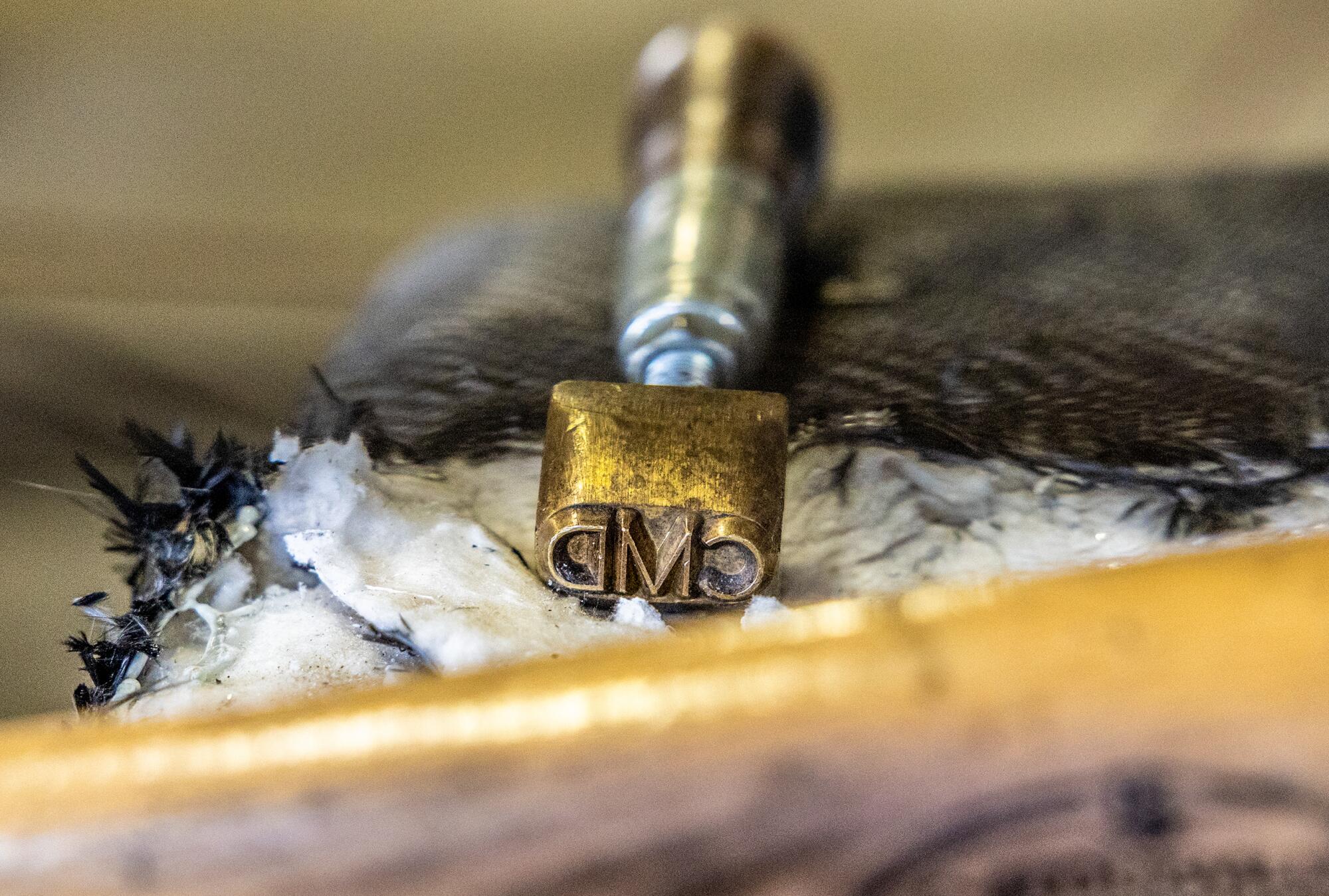
Mitchell’s initials, set into a stamp he uses to sign his artwork.
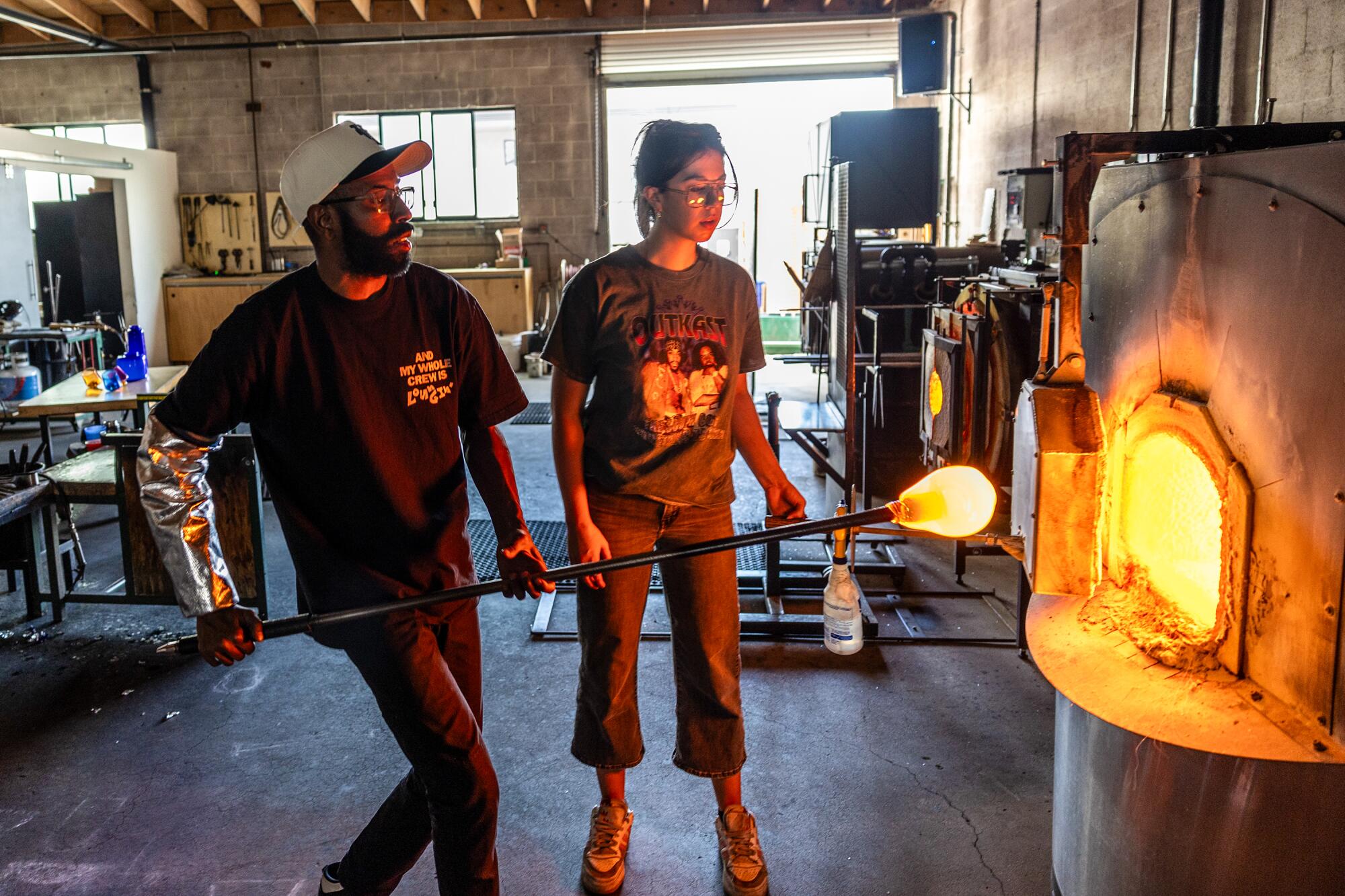
Assistant glassblower Sara Roller looks on as Cedric Mitchell removes molten glass from a furnace in his El Segundo studio.
Mitchell agrees. “Heath was one of the best things that happened to me,” he says as he stamps the bottom of a vase for Heath’s summer seasonal collection. “They gave me the opportunity to get better.”
Los Angeles lighting designer Brendan Ravenhill, who is working with Mitchell on a new fixture debuting in June, says: “Cedric’s funk is contagious” when it comes to craftsmanship. “We always look for people based in Southern California who are the best at what they do,” Ravenhill adds. Mitchell has the skills to produce and refine the difficult shape, he says.
Like the owners of so many small businesses in Los Angeles, Mitchell admits that 2023 was a tough year.
“It’s hard to do production in L.A. because nothing here is cheap. Natural gas prices and the cost of the studio rental are going up. Last year, I had to fly to Seattle to finish my order for Heath because the natural gas price rose 300%. I couldn’t even afford to blow glass here.”
Still, he acknowledges that many good things happened in a year of firsts: He had his first big residency at the Corning Museum of Glass in New York, allowing him to explore his craft without financial constraints. He also got married, welcomed a son and attended his first trade show in New York.
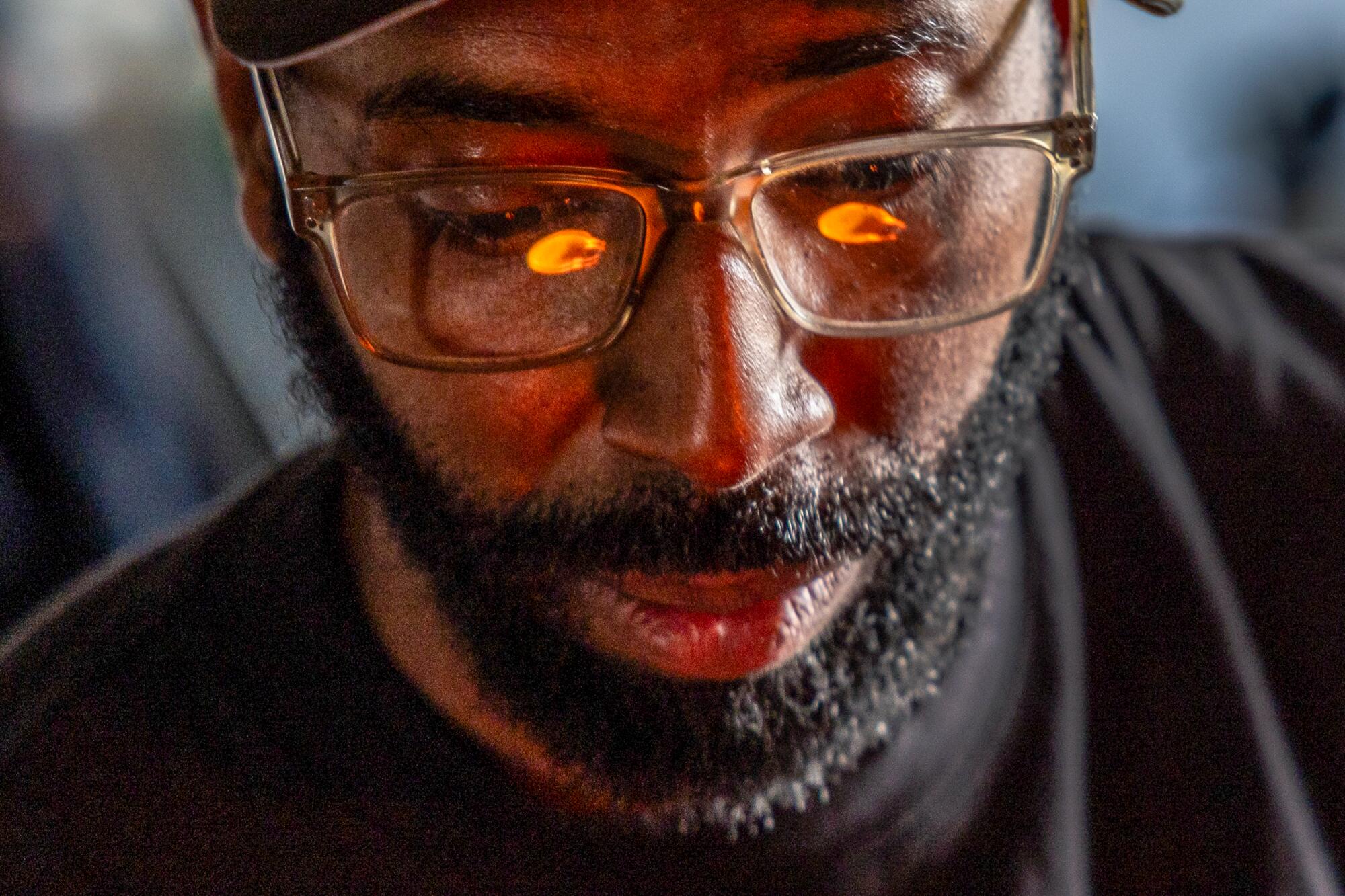
The Tulsa native says that when he googled “famous Black glassblowers,” he found only three.
(Robert Gauthier / Los Angeles Times)
Currently, Mitchell spends his days at his glassblowing workshop in El Segundo, creating drinkware, vases, decorative bottles and lighting. In addition to teaching, he has done brand alignment photo shoots with Nike, Fitbit and Elder Statesmen and is working with fellow glassblower and painter Corey Pemberton on Better Together, an event series designed to support Black and brown makers.
“Cedric is one of the most dedicated, hard-working artists I know,” says Pemberton, executive director of Crafting the Future, a nonprofit designed to introduce artists of color to the medium, residencies and entrepreneurship programs. “He fits more into a day than the average person would think possible. He can handle anything you throw at him and will do so with an incredibly calm demeanor.”
Beyond his work prowess, he’s a dedicated friend. “He is the type of friend you could call on for anything, and he’ll pull up, no questions asked,” Pemberton adds.
As someone who did not grow up exposed to art and glassblowing, Mitchell hopes to inspire a new generation of artists by rejuvenating the visual arts after-school program at the Watts Labor Community Action Community.
“No one is telling kids in underserved communities that they can be creators or makers,” Mitchell says of his proposal, which is pending approval. “We live in an entrepreneurial revolution, and people can be their own bosses and control the narrative of what they want to do. It’s scary, but it can be more risky working for someone. When you have ownership of something, you control the narrative. It’s like taking the stairs instead of the elevator, but it’s yours.”
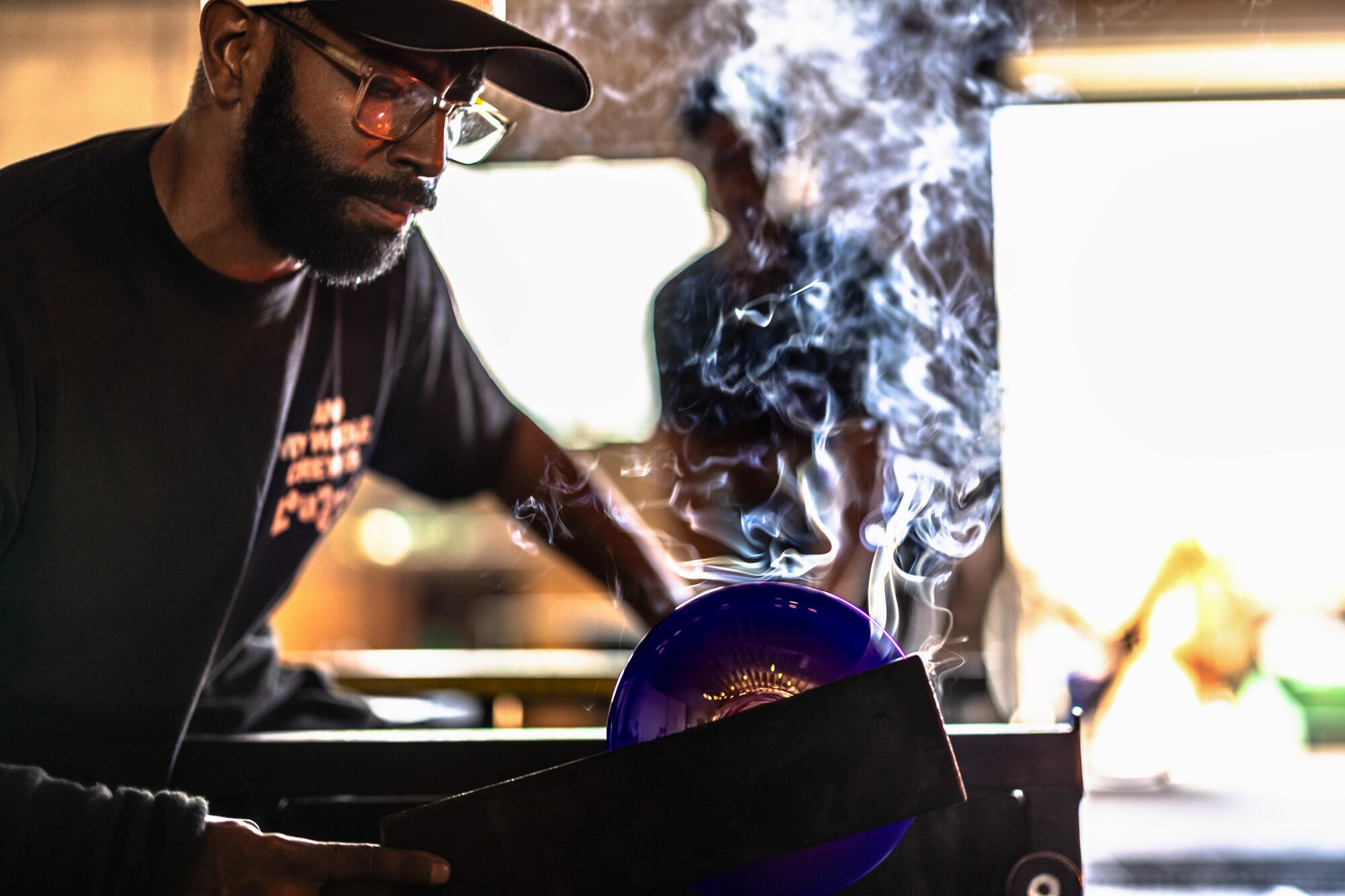
Cedric Mitchell turns what will eventually be a 7-inch vase in his El Segundo studio.
(Robert Gauthier / Los Angeles Times)

Lifestyle
The Morgan Library's quest to honor a matriarch in archiving : Consider This from NPR

Belle da Costa Greene in 1929.
Library of Congress
hide caption
toggle caption
Library of Congress

Belle da Costa Greene in 1929.
Library of Congress
Imagine yourself in Gilded Age New York, as you witness a glamorous, self-possessed young woman become an influential figure in wealthy social circles.
Known throughout the city, photographed by the press, she works with one of the richest men in the country collecting some of the world’s rarest books and manuscripts, for his personal collection.
Though it may sound like the plot of a movie, this story is taken from history. Referred to as one of the most fascinating librarians in American history, Belle da Costa Greene is the figure who is responsible for the depth and legacy of the Morgan Library’s collection, to this day.
You may have never heard of her — but the Morgan Library and Museum in New York is trying to change that.
You’re reading the Consider This newsletter, which unpacks one major news story each day. Subscribe here to get it delivered to your inbox, and listen to more from the Consider This podcast.
The Morgan Library
The library was founded by J. Pierpont Morgan, one of the richest and most powerful bankers in the early 20th century.
While it was originally intended to house J.P. Morgan’s personal collection, today, it houses a one-of-a-kind collection of medieval writings, rare books and illuminated manuscripts. That’s thanks in large part to Belle da Costa Greene.
She became the librarian for the collection in 1905 — and in 1924 was appointed director of the Morgan Library.
Erica Ciallela is a curator for “A Librarian’s Legacy” — a new exhibit that is part of the Morgan’s 100th anniversary celebrations. She says it’s hard to find an area of the study that Greene hasn’t influenced, telling NPR: “We could go on forever with everything she touched and created.”
The exhibit traces Greene’s life and her lasting impact on the role of libraries as public spaces for everyone, not just the educated elite.
“Our exhibition programs, our lecture programs, our collections that we do today, we can trace it all back to her becoming director and believing that this institution could be one of a kind in the world and a place for scholars everywhere to come and look at these amazing materials.”
Greene’s vision was also a key factor in defining the scope of this collection.
“She really was looking for one of a kind items, which is what sets our collection apart, because she really was like, ‘I want the best of the best.’ And that sometimes meant looking outside of what was popular. And she knew exactly what would make this collection and this building become a site.”
Passing to survive
Heading a library was an unusually prominent role for a woman at the turn of the last century, particularly for a Black woman. But this woman chose to pass as white to survive in a highly segregated America.
Ciallela says the decision was a family choice, spearheaded by her mother, Genevieve, who not only made the decision for all of Greene and her siblings to pass, but did it fairly early on, when Greene was still in school.
Da Costa Greene’s personal struggles with race and gender were lost to time and her own hand, as she burned her 10-volume set of diaries before her death.
“But we do have a letter she wrote to the art historian, Bernard Berenson, where she said that that is where she wrote things down that she dare not even think to herself. So what that means, unfortunately we’re never going to know. But, I mean, it’s got to have been a struggle. And, I mean, it’s actually incredible that she was made director as a woman,” Ciallela said.
This episode was produced by Jordan-Marie Smith and Kathryn Fink. It was edited by Jeanette Woods. Our executive producer is Sami Yenigun.
Lifestyle
Bhad Bhabie's Boyfriend Le Vaughn Spotted Out With Daughter After Cancer News

Bhad Bhabie‘s boyfriend, Le Vaughn, was spotted out in public for the first time since TMZ confirmed she’s been battling cancer.
Vaughn was in Tarzana in L.A. Friday, taking a casual stroll with their baby daughter — who they welcomed in March — in a stroller, making the most of some one-on-one time in the sunshine.
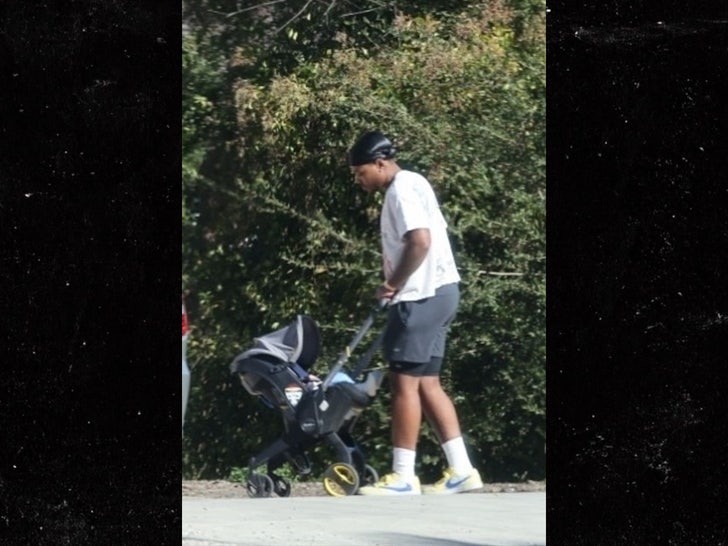
There was no sign of Bhabie, AKA Danielle Bregoli, who we’re told is currently under the care of a doctor.
Her health news comes after she concerned fans with a cryptic IG Story message, where she attributed her weight loss to cancer medication she was taking. She didn’t provide much context, but now it’s clear she’s been battling cancer.
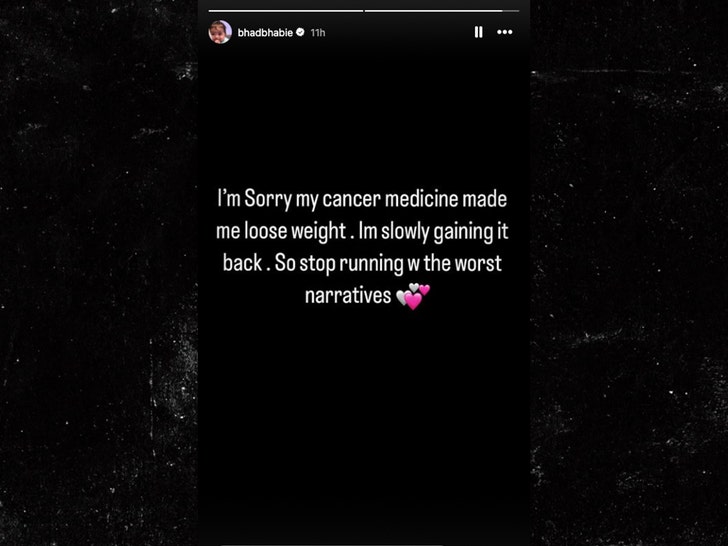
Looks like LV’s going to have to step up even more to take care of their daughter — and it seems like he’s back on track with BB on the personal front, especially after their past dramas.
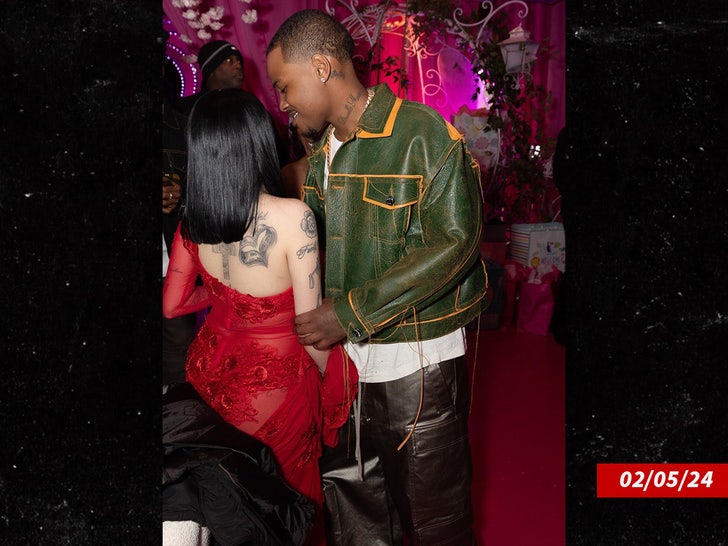
But that’s one less headache she doesn’t need while focusing on getting better.
Lifestyle
'Juror #2' is a thorny legal thriller — and possibly Clint Eastwood's last film

Nicholas Hoult (front row, center) plays Justin Kemp in Juror #2.
Warner Bros.
hide caption
toggle caption
Warner Bros.
Last week, Warner Bros. opened Juror #2 in limited release, with minimal fanfare, and no plans to report the film’s domestic box office. It’s not the typical treatment for a Clint Eastwood movie, especially one that some think might be the last Clint Eastwood movie. I hope they’re wrong. Either way, the fact that Eastwood’s longtime studio would bury his latest speaks to the various crises that have befallen the industry in general and Warner Bros. in particular. At 94, Eastwood seems ever more like an anomaly in American filmmaking: a Hollywood legend with nothing left to prove, still cranking out his unfussy, mid-budget dramas for a grown-up audience that the major studios have all but abandoned.

Juror #2 is actually one of his better-directed efforts of late, certainly compared with recent disappointments like Cry Macho and The Mule. There’s a little old-school John Grisham in this movie’s legal-thriller DNA, even though it features an original screenplay, by Jonathan Abrams.
Nicholas Hoult stars as Justin Kemp, a Georgia-based magazine writer who’s expecting a baby with his wife, played by Zoey Deutch. It’s a high-risk pregnancy, and so the timing isn’t ideal when Justin gets selected as a juror in a major murder trial.
The defendant, James Sythe, stands accused of killing his girlfriend, Kendall Carter, after the two had a heated argument in a bar one night. As the facts of the case emerge, Justin, who is recovering from alcoholism, realizes that he was at that same bar on the very night in question — and that he hit something he had assumed was a deer while driving home.

Suddenly alarmed that he could be more involved in Kendall’s death than he thought, Justin seeks advice from his AA sponsor, Larry, who also happens to be a lawyer. Larry, played by Kiefer Sutherland, advises Justin to keep quiet, lest he face serious prison time. But Justin, worried that his silence could send an innocent man to prison, tries to plead Sythe’s case during deliberations, which quickly turn contentious.
There’s a creakiness to the writing here; the bickering sounds forced, and some of the jurors veer toward cultural stereotypes. But others are more sharply drawn: J.K. Simmons brings his hard-nosed intelligence to the role of one of Justin’s few allies, while Cedric Yarbrough finds the simmering tension in every line as a juror convinced of the defendant’s guilt.
It all plays like a barbed riff on 12 Angry Men, where one man seeks to sway his fellow jurors, not to bring about justice so much as assuage his own conscience. But Justin isn’t the only character held up for moral scrutiny. The courtroom’s most compelling figure is the prosecutor, Faith, played with terrific nuance by Toni Collette. Faith does her job with skill, integrity and a great deal of ambition; she’s running for district attorney, and she knows that securing a conviction could help her chances.

Collette and Hoult played a mother and son in the 2002 comedy About a Boy. And while the actors don’t share too much screen time in Juror #2, beyond one doozy of a late scene, it’s still a pleasure to see them reunited more than 20 years later. Hoult is especially strong as a man wrestling quietly with past demons and present dilemmas, and whose response is to rationalize like crazy. After all, maybe Sythe, a man known for his rough past, really did kill his girlfriend. And even if he didn’t, how can Justin turn himself in, just as he and his wife are about to start a family?

Eastwood may take his characters to task, but he also sees the bigger picture. He’s long had a skeptical view of institutions and their failings, whether it’s a corrupt police force in Changeling or the manipulations of the media in movies like Sully and Richard Jewell. In Juror #2, he takes measured aim at the American justice system, from the dogged attorneys muddling their way through the evidence to the exhausted jurors who just want to deliver a quick verdict to the procedural fault lines and blind spots that can make the truth seem so elusive.
It’s a thorny, thoughtful film, and I wish its own studio had more confidence in it. If Eastwood does make another one, I wouldn’t mind seeing him take on another broken American system rife with cynicism, self-interest and compromise — and that, of course, is Hollywood itself.
-
Business1 week ago
Carol Lombardini, studio negotiator during Hollywood strikes, to step down
-

 Health1 week ago
Health1 week agoJust Walking Can Help You Lose Weight: Try These Simple Fat-Burning Tips!
-
Business7 days ago
Hall of Fame won't get Freddie Freeman's grand slam ball, but Dodgers donate World Series memorabilia
-

 Culture6 days ago
Culture6 days agoYankees’ Gerrit Cole opts out of contract, per source: How New York could prevent him from testing free agency
-

 Culture4 days ago
Culture4 days agoTry This Quiz on Books That Were Made Into Great Space Movies
-

 Business1 week ago
Business1 week agoApple is trying to sell loyal iPhone users on AI tools. Here's what Apple Intelligence can do
-
/cdn.vox-cdn.com/uploads/chorus_asset/file/25299201/STK453_PRIVACY_B_CVirginia.jpg)
/cdn.vox-cdn.com/uploads/chorus_asset/file/25299201/STK453_PRIVACY_B_CVirginia.jpg) Technology7 days ago
Technology7 days agoAn Okta login bug bypassed checking passwords on some long usernames
-

 Politics1 week ago
Politics1 week agoTrump pledges 'America's new golden age' as he rallies in PA's post-industrial third-largest city











